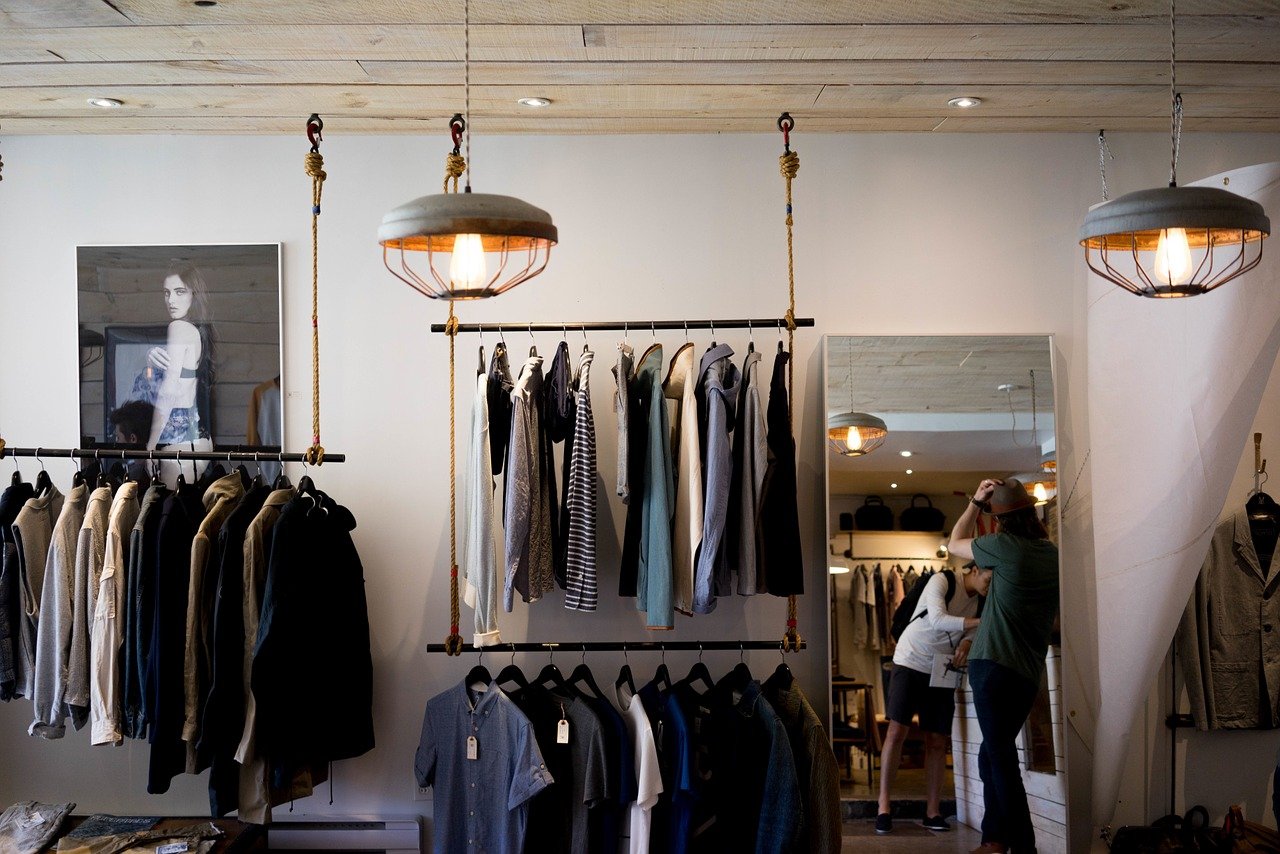Kleidung: Clothes in German
In this post we’ll learn lots of vocabulary to help you talk about clothes in German. First we’ll learn the basics with a lot of general vocabulary for clothes in German. Then we’ll learn vocabulary for professional and formal clothing. After that we’ll look at vocabulary for clothes that you’d wear in cold or hot weather. After that we’ll learn German vocabulary for shoes and then underwear. Finally we’ll learn German vocabulary for talking about how clothes fit and look, as well as things like fabrics and patterns. Ready?
General Vocabulary for Clothes in German
Let’s start with the basics: die Kleidung (clothes); das Hemd, -en (shirt); die Hose, -n (pants); die Jeans (jeans); das T-Shirt, -s (tee shirt); der Gürtel, -Ø (belt); tragen (to wear), anhaben (to have on); sich anziehen (to get dressed); sich ausziehen (to get undressed); ein Hemd anziehen (to put on a shirt), ein Hemd ausziehen (to take off a shirt).
- Ich habe ein schwarzes Hemd an.
I’m wearing a black shirt. - Ich habe ein weißes Hemd an.
I’m wearing/I have on a white shirt. - Am Wochenende trage ich immer Jeans.
I always wear jeans on the weekend. - Ich habe Jeans und ein T-Shirt an.
I’m wearing jeans and a tee shirt.
- Diese Jeans sind zu weit. Ich brauche einen Gürtel.
These jeans are too big. I need a belt. - Ich ziehe ein Hemd an.
I’m putting on a shirt. - Ich ziehe meine Jeans aus.
I’m taking off my jeans. - Ich ziehe mich jeden Morgen an.
I get dressed every morning. - Ich ziehe mich aus, bevor ich zu Bett gehe.
I take my clothes off before bed.
Professional and Formal Clothes in German
Now let’s look at some more vocabulary for less casual clothing: das Kleid, -er (dress); der Rock, -¨e (skirt); die Bluse, -n (blouse); der Herrenanzug, -¨e (man’s suit); das Damenkostüm, -e (a woman’s suit); die Krawatte, -n (tie); das Jackett, -s (suit jacket); der Smoking, -s (tuxedo); das Brautkleid, -er (wedding dress).
- Das ist eine hübsche Bluse.
That’s a nice blouse. - Für gewöhnlich trägt sie bei der Arbeit einen Rock und eine Bluse.
She usually wears a skirt and a blouse at work. - Sie hat ein schwarzes Hemd und eine weiße Bluse an.
She’s wearing a black skirt and a white blouse. - Für gewöhnlich trägt er einen Anzug mit Krawatte.
He usually wears a suit and tie at work. - Ihr rotes Kleid ist schön.
Her red dress is beautiful. - Er hat viele blaue Anzüge.
He has a lot of blue suits. - Es ist ein formeller Anlass, also trägt er einen Smoking.
It’s a formal event, so he’s wearing a tuxedo. - Die Braut hat ein schönes Brautkleid an.
The bride is wearing a beautiful wedding dress. - Welche Farbe hat die Krawatte, die du zu diesem Jackett trägst?
What color tie are you going to wear with that jacket?
Cold Weather Clothes in German
Now let’s look at some clothing you may wear when it’s cold: der Pullover, -Ø (sweater); das Sweatshirt, -s (sweatshirt); der Mantel, -¨Ø (coat); die Jacke, -n (jacket); die Handschuhe (gloves); die Fausthandschuhe (mittens); das Halstuch, -¨er (scarf); der Hut, -¨e (hat); der Regenmantel, -¨Ø (raincoat); der (Regen)schirm, -e (umbrella); der Kapuzenpulli, -s (hoodie).
- Es ist kalt! Ich ziehe einen Pullover an.
It’s cold! I’m wearing a sweater. - Wenn es kalt ist, ziehe ich einen Kapuzenpulli an.
I put on a sweater when it’s chilly. - Kann ich mir einen Kapuzenpulli leihen?
Can I borrow a hoodie? - Ich nehme meine Jacke mit. Vielleicht wird es heute Abend kühl.
I’m going to bring my jacket. It may be chilly tonight. - Er trägt immer eine Jeansjacke / eine Lederjacke / eine Motorradjacke.
He always wears a jeans jacket / a leather jacket / a motorcycle jacket. - Wenn es kalt ist, trage ich einen Mantel, einen Hut und ein Halstuch.
I wear a coat, a hat, and a scarf when it’s cold. - Vergiss nicht deine (Faust)handschuhe.
Don’t forget your gloves/mittens. - Heute brauchst du einen Hut.
You need a hat today. - In meiner Wohnung ist es kalt, also habe ich ein Sweatshirt an.
It’s cold in my apartment, so I’m wearing a sweatshirt. - Es regnet, aber ich habe meinen Schirm nicht dabei.
It’s raining, but I don’t have my umbrella. - Heute ziehe ich einen Regenmantel an.
I’m going to wear a raincoat today.
Hot Weather Clothes in German
When the weather is hot, you probably want to know how to say: die Shorts (shorts); der Badeanzug, -¨e (bathing suit); die Badehose, -n (swimming trunks); der Bikini, -s (bikini); das Trägerhemd, -en (tank top); die Sonnenbrille, -n (sunglasses); die Baseballkappe, -n (baseball cap).
- Es ist warm! Ich ziehe Shorts an.
It’s hot! I’m wearing shorts. - Es ist echt warm heute, also ziehe ich Shorts an.
It’s really hot today, so I’m wearing shorts. - Wenn ich an den Strand / ins Schwimmbad gehe, ziehe ich einen Badeanzug an.
I put on a bathing suit when I go to the beach/pool. - Er hat eine Badehose an, und sie einen Bikini.
He’s wearing swimming trunks, and she’s wearing a bikini. - Im Sommer trägt er immer Trägerhemden.
He always wears tank tops in the summer. - Die Sonne scheint. Brauchst du deine Sonnenbrille?
It’s sunny. Do you need your sunglasses? - Ich habe immer eine Baseballkappe auf.
I always wear a baseball cap.
Shoes and Footwear in German
Now let’s look at some footwear: der Schuh, -e (shoes); der Strumpf, -¨e / die Socke, -n (socks); der Turnschuh, -e (sneakers); die Sandale, -n (sandals); der Flipflop, -s (flip-flops); der Stiefel, -Ø (boots); der Pantoffel, -n (slippers); der Absatz, -¨e (heels); hohe Absätze (high heels); der Schnürsenkel, -Ø (shoe laces).
- Ich brauche neue Schuhe.
I need new shoes. - Er hat schwarze Lederschuhe an.
He’s wearing black leather shoes. - Bei der Arbeit trägt sie normalerweise hochhackige Schuhe.
She usually wears heels to work. - Am Wochenende trage ich immer Turnschuhe.
I always wear sneakers on the weekend. - Am Strand trage ich Flipflops.
I wear flip-flops at the beach. - Im Sommer trage ich normalerweise Sandalen.
I usually wear sandals in the summer. - Bitte zieh im Haus deine Schuhe aus und zieh Pantoffeln an.
Please take your shoes off and put on slippers in the house. - Wenn es schneit, trage ich Stiefel.
I wear boots when it’s snowing. - Zieh deine Turnschuhe an und lass uns Basketball spielen gehen.
Put on your sneakers and let’s go play basketball. - Pass auf! Deine Schnürsenkel sind auf.
Be careful! Your shoe laces are untied.
Underwear in German
Now let’s look at vocabulary for what you wear under everything else: die Unterwäsche (underwear); die Unterhose, -n (underpants); das Unterhemd, -en (an undershirt); die Boxershorts (boxers); der Schlüpfer, -Ø (panties); der BH, -s / der Büstenhalter, -Ø (a bra).
- Ich muss neue Unterwäsche kaufen.
I need to buy new underwear. - Ich muss die Wäsche machen, ich habe keine sauberen Unterhosen mehr.
I need to do laundry, I don’t have any clean underpants. - Sie hat einen BH und einen Schlüpfer an.
She wears a bra and panties. - Er trägt immer Boxershorts.
He always wears boxers. - Ich schlafe in Boxershorts und Unterhemd.
I sleep in boxers and an undershirt.
Talking about How Clothes Fit in German
Here’s some vocabulary that you can use to talk about clothing:
- Was ist deine Schuhgröße?
What size shoe do you wear? - Ich trage Größe 50.
I wear a size 50. - Dieses Hemd ist zu groß/klein/eng/weit.
This shirt is too big/small/tight/loose. - Diese Hose passt nicht.
These pants don’t fit. - Diese Turnschuhe passen sehr gut.
These sneakers fit very well. - Dieser Pulli ist warm und angenehm zu tragen.
This sweater is warm and comfortable. - In diesen Schuhen tun mir die Füße weh!
These shoes hurt my feet! - Die Jacke steht dir echt gut.
That jacket looks really good on you. - Die Hose steht dir nicht gut.
Those pants don’t look good on you. - Das Hemd passt nicht zu der Hose.
That shirt doesn’t match those pants.
Fabrics and Patterns in German
Finally, let’s look at some vocabulary related to fabrics, designs, and more: die Baumwolle (cotton); die Seide (silk); die Wolle (wool); das Leder (leather); der Streifen, -Ø (stripes); das Punktmuster (polka dots); das Muster, Ø (pattern); der Knopf, -¨e (button); kurzärmelig (short-sleeved); langärmelig (long-sleeved); der Reißverschluss, -¨e (zipper); die Gürtelschnalle, -n (belt buckle).
- Ich liebe diesen Stoff!
I love this fabric! - Mir gefällt das gestreifte Hemd.
I like the striped shirt. - Ihre Bluse hat ein Blumenmuster.
Her blouse has a floral pattern. - Sie hat einen Rock mit Punktmuster an.
She’s wearing a shirt with polka dots. - Aus welchem Stoff ist das Hemd?
What fabric is that shirt made of? - Ich trage nur Baumwolle.
I only wear cotton. - Mein Woll-Pulli ist sehr warm.
My wool sweater is very warm. - Das Seidenhemd ist schön, aber teuer!
The silk blouse is beautiful, but expensive! - Ziehst du ein kurzärmeliges oder langärmeliges Hemd an?
Are you wearing a short-sleeved shirt or a long-sleeved shirt? - Mir ist der Knopf abgefallen!
My button came off! - Dein Reißverschluss (coll. Hosenstall) ist auf!
Your zipper is open!
Get on the road to speaking German with the Language Garage!
We hope you’ve enjoyed learning how to talk about clothes in German. If you’d like to learn more:
- Create a free Language Garage account to access tons of German vocabulary, grammar, and culture.
- Follow us on Facebook, LinkedIn, BlueSky, Twitter, Threads, Mastodon, Instagram, or Pinterest. We publish lots of German vocabulary, grammar, and culture notes, so it’s a great way to pick up some new vocabulary and practice.
- Check out our other posts on German language, culture, and more.
- Enroll in affordable, flexible, and personalized private online German lessons or sign up for a small group online German class.
Image by Free-Photos from Pixabay






